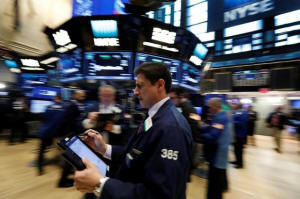|
Some bank bulls grow wary
on policy uncertainty
 Send a link to a friend
Send a link to a friend
 [March 11, 2017]
By Sinead Carew [March 11, 2017]
By Sinead Carew
(Reuters) - Bank shares have been the
runaway winners of the post-election U.S. stock market boom as investors
wagered that higher interest rates, lighter regulation, lower taxes and
faster economic growth would boost profits for lenders.
Up 32 percent since the election of Donald Trump, the S&P 500's bank
index <.SPXBK> has outpaced the wider market's gain by roughly 3-to-1.
Now, however, a changing dynamic in the bond market as the U.S. Federal
Reserve gears up to raise interest rates at a faster pace than many had
previously expected is beginning to give pause to some early bank stock
bulls.
With another strong U.S. jobs report in the books, the Fed is widely
expected to raise overnight interest rates on Wednesday, and is now seen
delivering three rate hikes in 2017.
Rising rates can boost bank profits, but bank profitability also hinges
on the difference between short-term rates, like those set by the Fed
and which tend to mark the cost for banks to acquire their funds, and
long-term rates, which serve as benchmarks for what banks charge their
customers for loans.
When that difference, or spread, is large, bank profits can rise
rapidly. When it narrows, or flattens, profit growth can suffer.

At issue now is what some investors see as a growing risk of a
flattening yield curve under a more aggressive rate-hike path by the
Fed. Forwards pricing for 2- and 10-year Treasury yields suggests the
spread between them will narrow to about 93 basis points by year-end
from the current 122 points.
That is why Jeffrey Gundlach, chief executive officer at DoubleLine
Capital and an early buyer of the Trump rally, said he has sold his
financial stocks.
"When the Fed tightens more than once a year, historically it is very
consistent with a flatter curve," Gundlach said. "The yield curve won't
help the sector."
In the month after the Nov. 8 U.S. Presidential election the S&P 500
bank index rose 24 percent. Since then the stocks have risen 5.7 percent
as many investors awaited concrete signs of regulatory and tax reform.
"Post-election, that was the easy money on financials right there,"
DoubleLine's Gundlach said.
[to top of second column] |

Traders work on the floor of the New York Stock Exchange (NYSE) in
New York, U.S., March 8, 2017. REUTERS/Brendan McDermid

MORE THAN JUST THE CURVE
To be sure, the bank rally has been grounded on more than just rate hike
expectations and yield curve forecasts. Investor interest has also been stoked
by assumptions about Trump's agenda in Washington.
Investors have been betting that Trump's promises of tax cuts would boost
consumer spending and company profits, which would drive loan demand. Meanwhile,
his promise to slash regulations could also cut compliance costs and allow banks
to expand their loan portfolios more rapidly than possible under restrictions
imposed following the financial crisis.
That is among the reasons why David Lebovitz, global market strategist at J.P.
Morgan Asset Management, still expects more gains for financial stocks.
Even if regulatory and tax reform looks like it will take a long time, investors
will likely be patient as long as Trump's administration provides more specifics
on its plans including timetables, Lebovitz said.
But he cautioned that "disappointment on the policy front is the biggest risk"
to stocks right now as investors have priced in policy changes already.
Paul Nolte, portfolio manager at Kingsview Asset Management in Chicago, said
that the bank sector's outperformance may be "done" but stopped short of calling
for a correction.
"I'm not sure investors are looking at the shifting yields and market
conditions. It seems to be buy and worry about the 'why' later," he said.
(Additional reporting by Jennifer Ablan and Richard Leong in New York.; Editing
by Dan Burns and Meredith Mazzilli)
[© 2017 Thomson Reuters. All rights
reserved.] Copyright 2017 Reuters. All rights reserved. This material may not be published,
broadcast, rewritten or redistributed.
 |